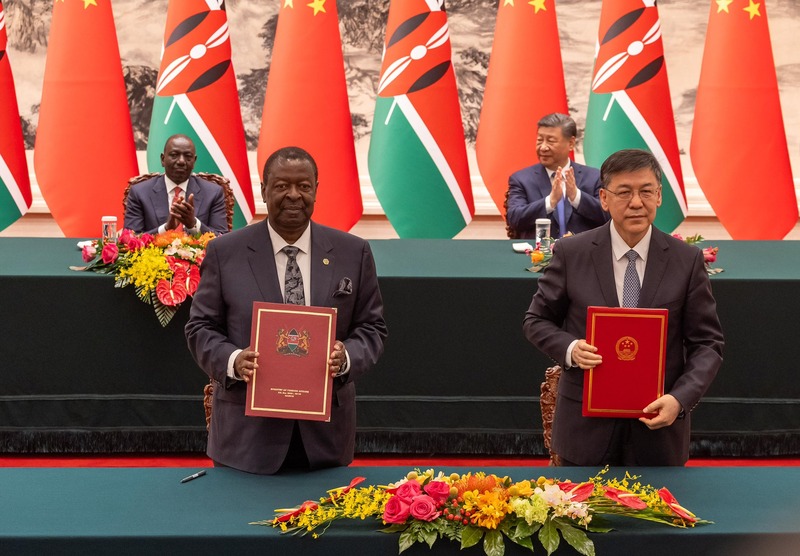Kenya’s trade deficit narrows by Sh19.2 bn in Q2 - KNBS

Net exports of services similarly rose from Sh27.4 billion to Sh43.6 billion in the second quarter of 2024, it adds in part.
Increased export trade in merchandise goods and services in the three months to June this year did enough to narrow the country's trade deficit by Sh19.2 billion.
A trade deficit occurs when the value of a country's imports exceeds the value of its exports.
More To Read
- Kenya’s economic growth to be powered by women and diaspora remittances -Report
- Kenya’s economy projected to grow by 5 per cent in 2025, easing cost of living pressures
- Billow Kerrow: Kenya's economic growth reliant on Ruto's fight against graft
- Africa set for stronger growth in 2025 as global prospect remains subdued- report
"In the second quarter of 2024, trade balance narrowed to a deficit of Sh383.8 billion from a deficit of Sh403.0 billion in the same quarter of 2023," the KNBS Q2 balance of payments report reads.
"This improvement was supported by an increase in exports of merchandise goods from Sh249.1 billion during the second quarter of 2023 to Sh276.3 billion during the second quarter of 2024."
Net exports of services similarly rose from Sh27.4 billion to Sh43.6 billion in the second quarter of 2024, it adds in part.
The statistics body says the increased services export was as a result of marginal increases in exports of transport and telecommunications services, coupled with a notable reduction in imports across the majority of the service categories.
Conversely, during the period under review, imports of merchandise goods, valued on a Free On Board (FOB) basis, increased by 2.3 per cent to Sh617.5 billion primarily driven by increased imports of industrial machinery.
FOB is a term used in international shipping and includes delivery costs up to a specified point covered by the seller.
Consequently, the current account deficit improved by 34.5 per cent to Sh104.1 billion.
A country's current account records the value of exports and imports of goods and services and international transfers of capital.
It is one of the two components of the balance of payments, the other being the capital account.
The current account may be positive (a surplus) or negative (a deficit) where positive means the country is a net exporter and negative means it is a net importer of goods and services.
Apart from increased export trade, the report exhibits that remittance inflows also continued to shore up the current account and amounted to Sh157.4 billion in the second quarter of 2024 compared to Sh140.5 billion recorded in the corresponding quarter of 2023.
Value of domestic exports and imports
Revenue from domestic exports marginally declined from Sh225.7 billion in the second quarter of 2023 to Sh223.3 billion largely occasioned by significant decreases in earnings from domestic exports of coffee, iron and steel, industrial machinery; and paper and paperboard.
Despite the marginal decline in the overall value of domestic exports, earnings from exports of articles of apparel and clothing accessories; and tea increased by 7.5 per cent and 2.0 per cent, respectively, over the same period.
This was mainly on account of increased quantities of exported tea, and articles of apparel and clothing accessories
Expenditure on imports in the period under review amounted to Sh659.5 billion, an increase of Sh7.7 billion from the same quarter of 2023 largely driven by increased expenditure in imports of industrial machinery, and aircraft, associated equipment and parts thereof.
Other imported commodities which registered notable increases during the review period were unmilled wheat (24.6%), telecommunication equipment and parts (83.1%), and chemical fertilizers (41.7%).
Conversely, there were significant declines in the value of imported iron and steel, and rice which dropped from Sh39.3 billion and Sh27.0 billion in the second quarter of 2023 to Sh22.5 billion and Sh11.6 billion respectively, in the second quarter of 2024.
Direction of merchandise trade
The bulk of the exports were destined for Africa and valued at Sh99.1 billion, albeit registering a decline of 5.1 per cent compared to the same quarter of 2023.
The reduction in export earnings was largely attributable to declines in exports to Egypt, Somalia and Ethiopia which decreased by 31.0, 42.0 and 23.5 percent, respectively.
On the contrary, there were increased export earnings from Uganda largely on account of increased domestic exports of food preparations for animals to this destination.
During the review period, total exports to Asia registered an increase of 52.2 per cent from Sh60.2 billion in the second quarter of 2023, largely on account of increased re-exports of kerosene-type jet fuel to the United Arab Emirates and Saudi Arabia.
In Western Europe, revenue from exports to the European Union (EU) market shrunk from Sh42.0 billion in the second quarter of 2023 to Sh38.3 billion in the second quarter of 2024, translating to a decrease of 8.6 per cent.
The decline was largely as a result of decreased exports to the Netherlands which went down from Sh21.3 billion in the second quarter of 2023 to Sh15.7 billion in the quarter under review.
This resulted from a reduction in the re-exports of kerosene-type jet fuel to this destination.
Exports to America increased by 18.6 per cent from the second quarter of 2023 to Sh23.6 billion in the same quarter of 2024 primarily supported by increased re-exports of kerosene-type jet fuel to the United States of America.
On the other hand, the total value of imports in the second quarter of 2024 amounted to Sh659.5 billion representing an increase of 1.2 percent compared to the same quarter of 2023.
The value of imports from Asia recorded a decline of 2.3 per cent to Sh435.2 billion in the second quarter of 2024 compared to the same quarter of 2023.
In spite of this decline, Asia remained the leading source of imports with a share of 66.0 per cent of the total import bill in the quarter under review.
The decline in imports from Asia was mainly on account of a significant reduction in imports from Saudi Arabia, United Arab Emirates and India, which jointly declined by Sh108.6 billion compared to the second quarter of 2023.
Expenditure on imports from Africa declined by 5.1 per cent to Sh64.0 billion compared to the corresponding quarter of 2023.
The drop was primarily attributable to a decline in the value of imported iron and steel; and maize from South Africa.
In contrast, imports from Tanzania rose by 36.9 per cent, partly on account of increased importation of rice and chemical fertilizers during the period under review.
Top Stories Today












































